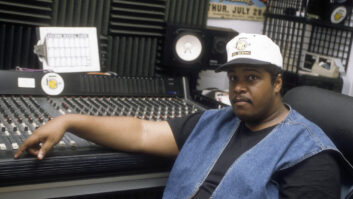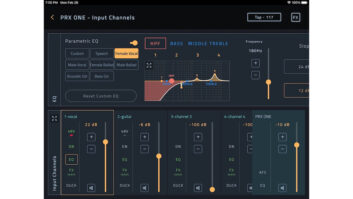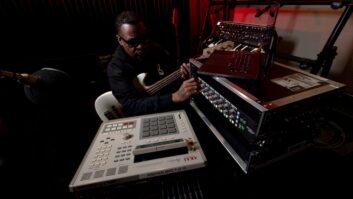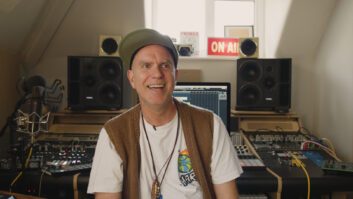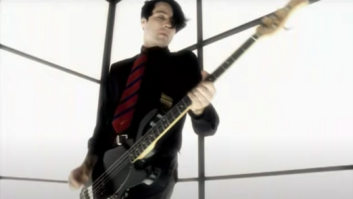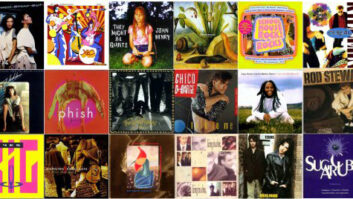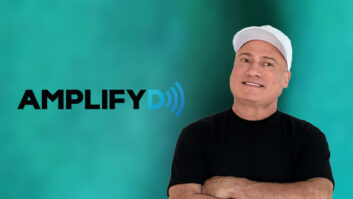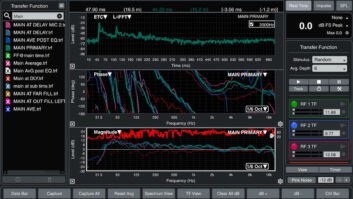Hybrid analog & digital studio mixing hits with Dangerous Music 2-Bus
Producer Anthony J. Resta at “Bopnique Musique� studios
Edmeston, NY – April 19, 2010 – From their “Bopnique Musique” studios north of Boston, Producer Anthony J. Resta and his mix engineer Karyadi Sutedja have made their impressive list of clients into fans of their unique style and sound – and platinum and gold records. Some highlights of artists they’ve worked with include production and mixing for Duran Duran (30 tracks), Collective Soul, who are 10-year clients, Megadeth, Guster, Shawn Mullins, Perry Ferrall among many others. Although the 3700 square foot studio space has a lot of key equipment, Resta gives special praise to what the Dangerous Music 2-Bus analog-summing amp brings to their sound.
Describing how the Dangerous 2-Bus fits in to their Pro Tools-based mixing system, Resta says, “Basically we send out stereo stems from the mix to our outboard gear –
we use pairs of Neve 1072’s and 1073’s, pairs of Focusrite RED and ISA 110’s, Universal Audio 610’s. We have a bunch of different configurations that we use to buss audio out of Pro Tools, through the outboard and then to the Dangerous 2-Bus, where the final mix is summed to stereo. Naturally we do the automation all in Pro Tools so it’s super easy to recall a mix. The Dangerous 2-Bus makes the stereo image wider and there’s much more headroom, and we notice a tighter low-end – it’s made a huge difference in the sound of the records we’ve been making!”
Engineer Karyadi adds, “The analog summing process of the Dangerous 2-Bus brings back the true depth of a mix – space perception created in the mix and/or recording by using reverb, echo, or actual room mic’ing – that was missing when the mixing was done 100% inside the box. When using the 2-Bus the stereo image becomes much clearer, the spatial placement of tracks in the mix are more pin-pointed, and the mix will not collapse even when it is getting dense, something that we used to only be able to get when mixing on a high-end analog console. The 2-Bus has massive headroom and definitely feels like you’re working on a high-end analog board. The low-end is tighter and a lot more focused. One of the factors that made us choose the Dangerous 2-Bus over other analog summing devices is its simple signal path design and high quality components – it has none of the unnecessary bells and whistles (pan, mute, individual level trim pot or fader, etc) that line mixer-style summing devices have, so it makes it possible and very easy to accurately recall mixes, which a very important factor for us.”
Analog equipment and the sound of analog gear like the Dangerous 2-Bus is important in Resta’s process for mixing, “We are known for making very analog sounding recordings, a lot of people can’t believe what we are doing is not tape. We use the EL-7 Fatso Jr; we use the Phoenix Crane Song software, and the old Magneto plug-in with the 30ips and 15ips settings. We work really hard to get that sound, even just in the way we mic drums. We didn’t switch over to digital until 2001. We’ve been hardcore analog all the way.”
But times have changed and the Dangerous 2-Bus coupled with classic analog outboard gear has allowed Resta to enter the digital world while retaining that analog sound, “It just became a thing of convenience with being able to edit performances, and to keep up with the pace that people expect you to make records. There’s no way you can sit there rewinding two 24-tracks waiting for them to sync up to do vocal rides when people want the song done in two days!” Resta added about the sound of the 2-Bus, “I am not a scientific wizard or anything, I just know what I like and this box has made a big difference in the sound of our mixes. We’re not a cookie cutter mixing operation, like a lot of these guys that do 6-hour mixes, copying the master to a specific mixing template, essentially having the tracks come up on the same faders and processing chains, and the mix is almost ready to print. We don’t work like that, it takes us about a day and half to do a mix – we start from the ground up. We treat it like a specific piece of art for each and every song. Music can be commercially viable but it can also be innovative and take some chances.”
The studio recently paired the Dangerous 2-Bus with new D-to-A converters by Lavry that Resta had heard at Vlado Meller’s mastering studio and liked, which is also where he first was introduced to Dangerous Music equipment, “I started attending mastering sessions at Vlado’s and noticed that there were a lot of Dangerous Music components in his system. I started asking Vlado about it and basically he turned me onto Dangerous Music. Seeing Vlado using Dangerous gear, I figure a guy who has 21 records that he had mastered up for Grammys in one year, if he’s using the stuff it’s gotta’ be good.”
Right now Resta uses the 16-channel Dangerous 2-Bus to sum his stems, but he sees more inputs in his future, “We’re going to be moving up to 32-channels very soon, because we find ourselves saying ‘If we just had and couple pairs…’ I definitely plan on adding another 2-Bus.”
Resta has been working side by side with his mix engineer, Karyadi Sutedja, (who was on the Grammy ballot in 2008 in the ‘Best Engineered Non-classical’ category for Collective Soul’s “Afterwards”) and credits him with being the man behind the cool and unusual routing and other technical aspects of Bopnique, “Karyadi is very innovative with the way he uses outboard gear and stem mixing, he’s got a lot of tricks up his sleeve. He’s a big fan of Tony Maserati, who it turns out is another long-time 2-Bus user.”
On the way mixes get from his studio to mastering, Resta comments, “We’ve been printing mixes outside of Pro Tools from the Dangerous 2-Bus main outputs to the Alesis Masterlink at 44.1 24-bit, and our mastering engineer Vlado Meller really prefers that to the tracks recorded back to Pro Tools. He finds that the Masterlink mixes sound more open.”
“The summed stereo signal is patched to Millenia NSEQ-2 (with J-FET setting), then to a Dramastic Audio Obsidian stereo bus Compressor,” explains Karyadi. “The compressor is side-chain triggered by EQed Beats and Drums. The EQ setting and level for the side chain is customized according to the song and to how I want the compressor hit; the compressor is set at 2:1, or occasionally 4:1 with fast attack and release; no make up gain is used as it only adds noise; attenuation is usually between 1 and 3 dB. Then the signal goes to the Lavry Blue A-to-D converter, then back to Pro Tools. We use a limiter plug-in to add 2 more dB of loudness. When printing final mixes, however, the final output signal is sent to the Alesis Masterlink at 24 bit and 44.1k sampling rate from Pro Tools via AES/EBU with the Limiter BYPASSED, so our mastering engineer Vlado Meller can do his own signal boost. We choose to record the Dangerous 2-Bus summed output back to Pro Tools because a lot of times when doing mix recalls we find the need to subtly add more EQ and/or compression on the final signal chain that is better when done with plug-ins.
Returning to his producing philosophy and its connection with recording and mixing Resta says, “Being a producer and multi instrumentalist, in the end for me it’s the right singer and right song. At the end of the day, that’s what makes a great record. People can talk about gear until the end of time, but until you record something that’s worth recording you don’t have anything. I like to emphasize that.”
A multi-instrumentalist, Resta often surprises clients with anything from adding or replacing entire drum performances, adding extra guitar overdubs and custom modular synthesizer sounds, to flutes, clarinets, accordion, and toy piano. “The element of surprise is one factor that keeps my mix clients sending their projects to Bopnique,” says Resta.
Resta and Karyadi of “Bopnique Musique” studios have worked with many amazing artists, some highlights include production and mixing for Duran Duran (30 tracks), Collective Soul (10-year clients), Megadeth, Guster, Shawn Mullins, Perry Ferrall, Green River Ordinance, Need To Breath, Blondie, Del Marquis (of the Scissor Sisters), TV Mania, The New Collisions, along with an entire roster of new ‘Post Indie’ artists that are creating an entire sub-culture. Contact Bobnique at (978)-853-7579, Email: [email protected] or visit their website at: www.bopnique.com
About Dangerous Music, Inc.
Dangerous Music, Inc. designs and builds products that are indispensable to any DAW-based recording environment. Dangerous Music electronics designer Chris Muth has spent over 20 years working in and designing custom equipment for top recording and mastering studios. Muth and company founder Bob Muller pioneered the concept of the dedicated analog summing buss for digital audio workstations with the Dangerous 2-Bus in 2001. Today the company offers a wide range of products for recording, mastering, mixing and post-production facilities, all designed and built with mastering-quality standards and a practical aesthetic. Key products include the Dangerous 2-Bus and 2-Bus LT, Dangerous Monitor ST-SR and its Additional Switching System expansion units, Dangerous D-Box, Dangerous Master, Dangerous S&M, Dangerous Monitor and Dangerous MQ. For more information visit www.dangerousmusic.com phone 607-965-8011 or email: [email protected]
All trademarks are the property of their respective holders.
